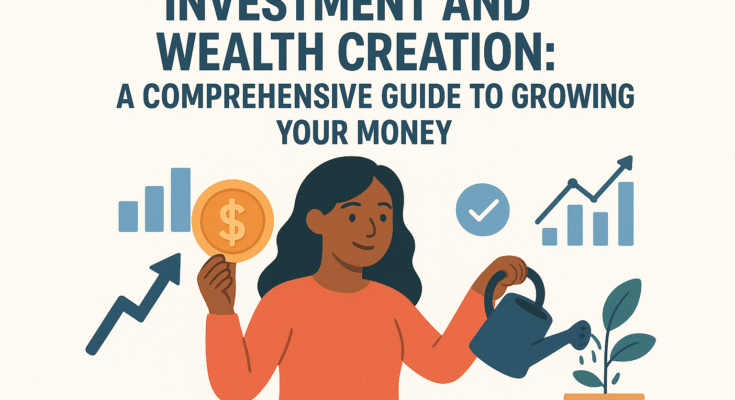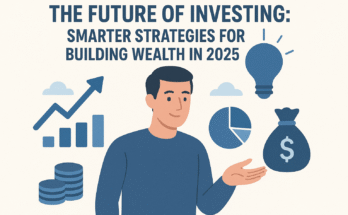Investment is one of the most powerful tools for building financial security and achieving long-term goals. It allows money to grow beyond the limits of ordinary savings, creating opportunities for wealth that can support both present and future needs. While saving money in a bank account is important, investment is what enables individuals to build true financial independence.
The essence of investing lies in putting money to work. Instead of sitting idle, capital is directed toward assets that have the potential to generate returns. These returns can come in the form of interest, dividends, rent, or appreciation in value. Over time, the compounding effect of reinvested earnings can transform even modest contributions into significant wealth.
Understanding how investments work, the risks involved, and the strategies that lead to success is crucial for anyone seeking to secure a stable financial future. The world of investment is broad, ranging from traditional assets like stocks and bonds to modern vehicles such as exchange-traded funds, cryptocurrencies, and real estate partnerships. Each carries its own opportunities and challenges, but the underlying goal remains the same: to grow wealth wisely and sustainably.
Why Investment Matters
The importance of investing goes beyond financial gain. It is about achieving freedom and stability. Investments provide a way to prepare for major life milestones, such as buying a home, funding education, or retiring comfortably. Without investment, reaching these goals often requires decades of savings and sacrifices that may still fall short due to inflation.
Inflation is one of the key reasons why investment is essential. When the cost of living rises, money that is not invested gradually loses its purchasing power. A hundred dollars saved today may not have the same value ten years from now. Investments, on the other hand, have the potential to outpace inflation, ensuring that wealth retains and increases its real value.
Investment also cultivates discipline. It encourages people to think about the future, plan ahead, and prioritize long-term benefits over short-term gratification. By setting aside funds for investment, individuals build habits that strengthen both financial literacy and resilience.
The Building Blocks of Investment
At the core of investing are several key asset classes that form the foundation of most portfolios. Stocks represent ownership in companies and provide the opportunity to benefit from their growth and profits. Bonds are essentially loans made to governments or corporations, offering steady interest payments in return. Real estate, often seen as a more tangible investment, generates income through rent and appreciation.
Mutual funds and exchange-traded funds combine money from multiple investors to create diversified portfolios managed by professionals. These vehicles make it easier for individuals to access a wide range of assets without having to research or buy them individually. Commodities such as gold, oil, and agricultural products provide another avenue for diversification, often serving as a hedge against inflation or market volatility.
Modern markets have also introduced newer opportunities. Cryptocurrencies, while highly volatile, have attracted attention as alternative assets. Crowdfunding platforms allow small investors to participate in projects once reserved for large institutions. Technology has opened access to global markets, enabling people to invest across borders with ease.
The Power of Compounding
One of the most important principles in investment is compounding. This occurs when earnings from investments are reinvested to generate their own earnings. Over time, this creates a snowball effect where growth accelerates. The earlier one begins investing, the greater the benefits of compounding become.
For example, an investment that earns annual returns of seven percent will double approximately every ten years. Someone who starts investing in their twenties and consistently contributes will accumulate far more wealth by retirement than someone who waits until their forties, even if the latter invests larger amounts. Time, therefore, is one of the most valuable assets an investor can have.
Managing Risks in Investment
Every investment involves risk. Stock prices can fall, companies can underperform, and markets can experience downturns. Bonds, while considered safer, may lose value if interest rates rise or if the issuer defaults. Real estate markets can stagnate, and newer assets like cryptocurrencies can fluctuate wildly.
Managing risk does not mean avoiding it altogether. Instead, it involves understanding potential downsides and taking steps to minimize them. Diversification is the most widely used strategy for risk management. By spreading investments across different asset classes, industries, and regions, the impact of a single poor-performing investment is reduced.
Another important factor is aligning investments with personal goals and timelines. Money needed in the short term should not be placed in highly volatile assets, while funds intended for long-term growth can be allocated to higher-risk opportunities with greater potential returns. A balanced approach ensures that investors can weather market fluctuations without being forced to sell at unfavorable times.
The Role of Emotions in Investing
Financial decisions are not purely logical. Emotions such as fear and greed often play a significant role in how investors act. During times of market decline, panic selling can lock in losses, while during periods of growth, overconfidence can lead to excessive risk-taking.
Successful investing requires discipline and emotional control. Sticking to a well-thought-out plan, avoiding impulsive decisions, and maintaining perspective during market fluctuations are all critical habits. Many investors benefit from setting clear goals and reviewing progress regularly rather than reacting to daily market movements.
Patience is another vital element. The temptation to chase quick gains often leads to disappointment, while long-term strategies focused on steady growth tend to yield better results. History shows that markets, despite short-term volatility, generally trend upward over time. Those who remain invested and consistent are usually rewarded.
Creating an Investment Strategy
An effective investment strategy is built on several principles. The first is clarity of goals. Whether the objective is retirement, education funding, or building wealth for future generations, knowing the purpose of investment guides decision-making. Each goal has a different timeline and level of acceptable risk, and portfolios should be tailored accordingly.
The second principle is diversification. A well-diversified portfolio balances growth assets like stocks with stable assets like bonds. Real estate and alternative investments can provide additional balance. Adjusting the mix over time, as circumstances and markets change, keeps the portfolio aligned with objectives.
The third principle is consistency. Regular contributions, even in small amounts, accumulate into substantial wealth over time. Dollar-cost averaging, which involves investing a fixed amount regularly regardless of market conditions, helps reduce the impact of volatility and removes the need to time the market.
Finally, periodic review is essential. Markets evolve, personal circumstances shift, and goals may change. Reviewing and rebalancing portfolios ensures that they remain on track and aligned with overall financial plans.
The Future of Investing
The investment landscape is changing rapidly. Technology is making it easier for individuals to access tools once available only to professionals. Robo-advisors provide automated portfolio management at low cost, while mobile apps allow instant trading and monitoring of assets. Artificial intelligence is being used to analyze data and predict trends, giving investors deeper insights into opportunities.
Sustainability is also becoming a major focus. Many investors now seek to align their portfolios with environmental, social, and governance principles. Companies that prioritize sustainability and ethical practices are increasingly seen as both responsible and profitable in the long term.
Globalization is expanding opportunities further. Investors are no longer limited to their local markets but can participate in growth across continents. This opens doors to sectors and regions that may provide higher returns than traditional domestic investments.
Final Thoughts
Investment is not simply about making money—it is about creating a secure and fulfilling future. It requires knowledge, patience, and discipline, but the rewards can be life-changing. By understanding the principles of investing, embracing diversification, managing risks, and staying committed to long-term goals, individuals can harness the power of money to work for them rather than against them.
Wealth creation through investment is a journey rather than a destination. The steps taken today, whether small or large, lay the foundation for opportunities tomorrow. In a world where financial independence is increasingly important, investment remains one of the most effective ways to achieve stability, growth, and lasting prosperity.


